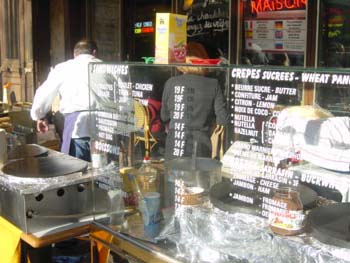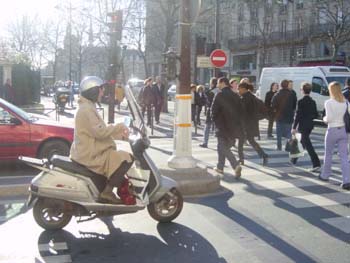|
Three or four days before
boarding a plane back to Paris from the United States,
I called the airline to reconfirm my flight and review
what is acceptable in a carry-on these days. I knew I
couldn’t bring sharp objects like a Swiss Army Knife,
though I seemed to have lost that anyway. I was curious
about the objects that weren’t obvious, like staplers,
shavers, etc. After waiting only a couple of minutes,
a woman came on the line and simply said "hello." For
a moment I thought I had the wrong number, forgetting
that I was already in the airline’s phone system.
I was simply not prepared for what is the most common
and appropriate way to answer a phone, because it is not
part of the script on a customer service line. After reconfirming
the flight, I asked her if I should bring my pair of electric
clippers onto the plane in the carry-on, or stow it away
in my luggage—my thinking was that it could look
like a bomb in the x-ray machine, and it might be better
to have them with me to show that it is operational as
a haircutter and nothing more. She advised me to put it
in my luggage, and I mentioned to her that this was the
first time I was flying out of the United States since
September 11th. She then began to confide in
me about how she learned of the events of that day, and
how the information was passed along from the airline
authorities to her and other employees who had to inform
worried passengers and customers. She told me she wanted
out of her job, that too much tragedy was making it difficult
for her. Surely that is just a temporary panic, I told
her, not knowing what else to say. Then she said that
several weeks ago a man called needing to get to some
city in South America the next day, and she had to tell
him that her airline didn’t fly that route, and she
advised him of another airline that did. That flight the
next day on that particular airline crashed, with no survivors.
She said she doesn’t know if he took that flight,
and didn’t have his name to be able to verify it,
but on top of the sadness she felt from Sept. 11th,
plus the accidental crash days later in Queens, she was
feeling overwhelmed by a sense of sadness, fear and responsibility.
While on the phone, I had a vague recollection of a flight
that had gone down, and now I see that it was a TAME airlines
flight that crashed into the Andes mountains with 92 people
aboard on January 29th. It seems strange that
someone flying from Equador to Columbia would be calling
a U.S. based airline—but I didn’t question this
customer service rep during the call as she continued
her outpouring of grief and guilt. It was both sad and
oddly fascinating to hear this protocol-breaking confessional
which included information about her family and details
of her own anger and frustrations. After about 20 minutes,
we said goodbye and good luck to one another. Until this
call, I hadn’t really thought about the effect of
plane crashes (to say nothing of Sept 11th
specifically) on airline employees not directly involved.
And here is this woman, who has finally found it impossible
to keep up her façade of PR cheerfulness for the
customers, so much so that she is unconcerned that this
call is possibly being recorded for quality assurance.
***
Passing through security
just before my flight, I put my carry-on on the conveyor
belt and walked through the metal detector. It started
to beep, so a security official checked me thoroughly
with the metal detector wand. Though I didn’t have
to remove my shoes or other clothing, I was instructed
to lower my pants at the hip and turn it inside out for
a moment. When I went to retrieve my backpack, I was told
that I would have to put my laptop back through. So I
took the backpack and walked it the ten feet distance
back over to the front of the scanning machine. Immediately
I was told by another security official that I shouldn’t
have walked back into the unsecure area, and I was told
to go back. I turned back to the original security official,
to explain to her what I was told, but she became a little
miffed that I didn’t listen to her and told me again
in a louder voice to send the laptop back through, but
this time to take out the laptop allowing it to be scanned
separately from the backpack. So as I walked back yet
again, I passed through the metal detector and set off
the alarm. A head of security came over and reprimanded
the first official for not knowing that once a person
has passed through into the secure area, they are not
to pass back into the unsecure area. That first official
snidely responded to nobody in particular, "Well nobody
told me that." Eventually I was given a plastic tub for
the laptop and it was taken from me by an official while
I waited, then was passed through the scanner again. A
moment later I was free to go.
 |
The plane was only half
full, which meant that I had nobody else in my two-seat
row, nor anyone in front of me or across the aisle. The
plane was a Boeing 777, a "triple seven," in the parlance
of the flight crew. This meant a personal video screen
and a higher quality of color coordination of the seat
material and carpeting. A dark, noble blue. Having my
own video monitor, one would think, allows for such sought-after
freedom of choice, and yet what was I left with? The Penny
Marshall film Riding in Cars With Boys starring
Drew Barrymore, and Glitter, the Mariah Carey debacle—which
I was drawn to inexplicably. This film, the few minutes
of it I watched, was not like Purple Rain or some
such thing. It was rather like Showgirls in how
tone deaf it is to present levels of hipness. It would
be like making Beat Street today, for the first
time, exactly as it was done in 1984. Lest I climb on
too high a horse, I remind myself and other Bob Dylan
fans that even he made Hearts
of Fire.
Still, as I watched
Mariah on my personal entertainment system in the most
advanced of commercial airplanes—I kept thinking
of that line in the first Superman movie, when
young Clark sits with Ma Kent just after Pa dies of a
heart attack. "All these powers, and I couldn’t even
save him."
 |
Driving back from the airport
through the streets of Paris, I was amazed at how different
everything felt. When I returned to Chicago after four
months abroad, there was new construction everywhere,
entire buildings spawned from the ground, enough to need
a re-acclimation to certain familiar intersections. But
in Paris, nothing is supposed to change. My apartment
building, despite its remodeled interior is from the late
17th century. And yet a new bakery down the
block is thriving and a nearby cozy café with an
antique automobile/train memorabilia theme has been taken
over by a slick club-like restaurant and bar with glowing
pastel fluorescents—which will probably be much more
successful. And all this change doesn’t stop with
the restaurants; the Euro has finally arrived. Having
left France using Francs and returned using Euros, I find
that as an American, I seem to have a leg up on understanding
value in a way I didn’t before; this is because the
Euro is equal to about 91 cents, so while French people
are trying to convert it in their heads by 6.55957 francs,
I see that the steak tartare is 11,50€ and
I know that means it’s something like $10. Though
I was happy to use francs, it is even easier now, given
my lack of quick math skills. But I still can’t figure
out which coins are which, making me just as much a novice
as everyone else. The Euro feels like a Bizarro Dollar,
a similar value where there are two-dollar coins and bills
that are almost as boring as ours. One of the delights
of other nations has been the multi-colored and -sized
currencies with pictures of artists, painters and writers—both
male and female, something that always seemed so much
more cultured than our symmetrically and chromatically
conservative dead presidents (and Hamilton and Franklin
of course—but still G-men). In any case, the Euro
bills, despite some color and variations in size, have
been neutered in the spirit of compromise—as evidenced
in its generic name as well. Gone are the celebrated faces
of Europe like Eiffel himself on franc bills or Montessori
on the Italian lire bills, replaced with innocuous images
of aqueducts and patterned windows and bridges for the
12 participating European Union nations. People aren’t
happy about this, but there is nothing they can do. On
February 18th, in France, the franc became
officially invalid as currency (the Banque de France will
still exchange it for free, but it can’t be used
to buy anything). Aside from a clip on the news this morning,
I’m betting it is an afterthought for most of the
population, even if they will continue to gripe about
the Euro for years to come.
***
AND SO IT GOES:
While cleaning out the
bag that was my carry-on, five days after my flight, I
reached into a small pocket. And there, in the small zippered
pocket on the back, was my double-bladed Swiss Army Knife.
|